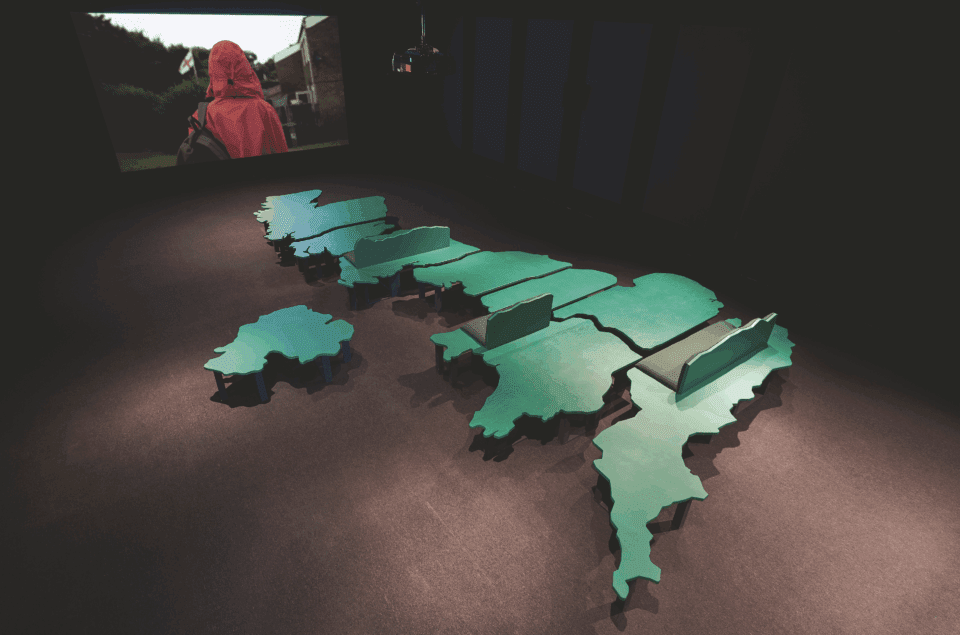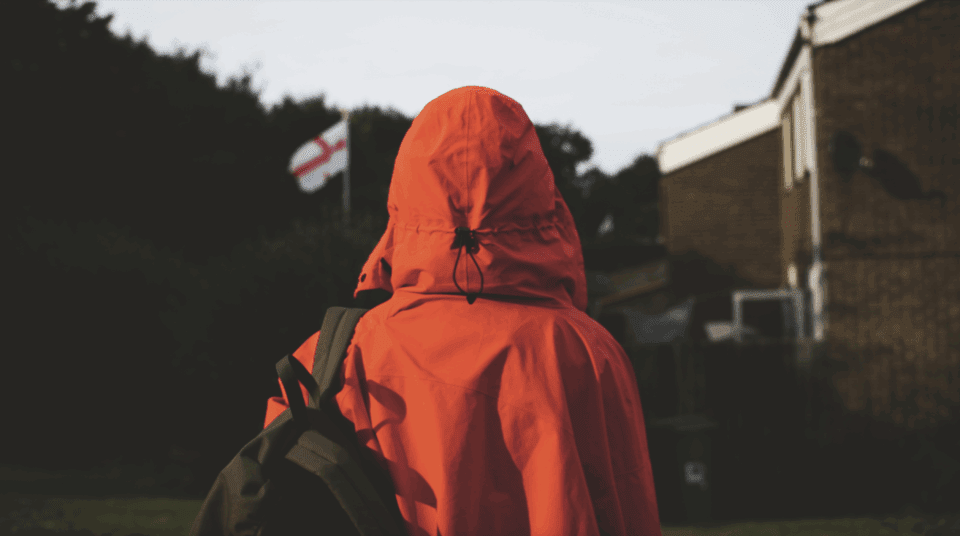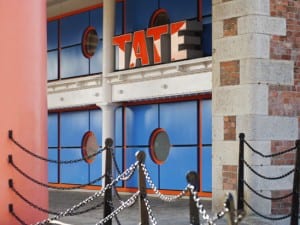Larry Achiampong (b. 1984) has more than 20 years of artistic practice to his name. In that time, he has established himself as one of the most important voices in contemporary art. The British-Ghanaian creative uses aural and visual archives, game design, film, live performance and still imagery to explore ideas surrounding class, cross-cultural, digital and gender identity. As a practitioner and an influential figure in the scene, Achiampong has lent his platform to advocating for social justice and challenging inequality in the arts. Now, he has taken the time to reflect upon his illustrious and far-reaching career in a new book. The work’s title, If It Don’t Exist, Build It, encapsulates his ethos. It is a rallying cry to carve out space, push boundaries and leave a mark on the world.
In 2023, Achiampong’s first feature film, Wayfinder, was longlisted for a BAFTA. Set during a pandemic, the story tracks the movements of a young girl on an intrepid journey across England. The piece also won the 2023 Aesthetica Art Prize. Achiampong is also a recipient of the Stanley Picker Fellowship and was nominated for the revered Jarman Award in 2021 and 2024. If It Don’t Exist, Build It celebrates two decades of innovation and features extended interviews with the artist, exploring the ideas behind his most ambitious projects. We spoke to Achiampong about the process of creating the book, what it was like to look back at on his creative practice so far and the nature of the creative industries today.

A: How did the idea for this project come about?
LA: It goes back to 2022 when my first major solo show, Wayfinder, was about to tour from Turner Contemporary in Margate to MK Gallery, Milton Keynes and Baltic, Gateshead. Just as it was about the kick-off, I was introduced to Tom Avery at Tate Publishing and he mentioned that he’d been following my work, was a fan of what I did and that there was interest in creating a catalogue of the show. I was honoured to be asked and thought that there was more that could be done. I felt the project could be about my practice more generally, since I’m nearly two decades into what I do, rather than about the show, which was already ongoing. So that’s how it started, through these early humble conversations but also through a desire to push the potential of what could be achieved.
A: What was it about making a book that particularly appealed to you?
LA: I experienced poverty as a kid, and I come from a lower working-class background. I know that a lot of people from a similar circumstance as myself don’t go to gallery shows. I’m not in the business of asking the question “how can we get people to go to galleries”, I’d rather think “how can we bring art to the people?” The book is part of that ongoing, wider process. I do that in other ways too, like releasing my first feature film, Wayfinder, in cinemas through limited release. It’s about finding methods to get the material out there without sending people to spaces where they feel ostracised, or where their stories actually tend to be mined for material.

A: You mentioned that you’re 20 years into your artistic career now. What was it like to reflect on your work so far?
LA: I had to remind myself of some things that I created, to be honest. A lot of the time, my head is just down. Working has always been something that my family has done and it’s a mentality that I’ve inherited: to just get on with stuff. I’d never had the opportunity to sit down and look across a range of material, even in a cataloguing nature. It was quite emotional on the one hand, seeing what had been created and telling myself, “You’ve made a lot of stuff.” I don’t think I’ll ever do a PhD, so I had a little joke with my mum when I presented her with the book, saying “here’s your PhD.” It was powerful to be in this environment where we could make decisions about how the work would be digested. It meant the world.
A: What was the process of deciding what was included, and what was going to be left out?
LA: I’ve made quite a few films – almost 20 now – so I’m familiar with the editing process. I knew going into it that there was only so much that would fit into the book, so I felt quite excited. It was nice to feel like there was more to say. In time, there will hopefully be space and opportunity to tell those stories too.
A: What do you hope people take away from reading the publication?
LA: My relationship with literature is quite a special one. I love comics and graphic novels, for example, but it’s only in the past 10 years or so that this material has been seen as literature. If we think of Alan Moore’s Watchmen series or V for Vendetta, the medium has been given more respect because, quite simply, the people who write and draw and create this material are just as serious as the people who focus solely on the written word. When I finished secondary school in 2000, I won an art competition and the prize was The Art Book. That was my first genuine dive into contemporary art. I didn’t really go to galleries until I was an adult, so it was special to be able to dip in and out of this world whenever I wanted. It has a profound affect on me and connected me with the art scene. I want this book to be the same for other people. I love making shows, but the reality is that it has a shelf life – it’s planned, developed, delivered and then taken down. But this is something people can take home, or even own as a community.

A: You’ve spoken a lot about class inequality, and have been a powerful voice in reports from media outlets like the Guardian about the reduction of creative opportunities for people from lower socio-economic backgrounds. What role do artists play in making sure everyone has an opportunity to be part of the creative industries?
LA: It’s a big question, but an important and valid one. There have been loads of people working in this space, who have influenced my filmmaking practice. Shane Meadows’ work is the most important to me, like Once Upon a Time in the Midlands (2002) or This is England (2006). Those films are 20 years old, but the way they speak about lower working-class experience is still really timely. Artists play a huge role in talking about this topic. One of the biggest conversations that needs to be had is around privilege, because there are a lot of creatives who are coming from hugely privileged backgrounds. This means that we need to look at equity rather than equality. Instead of putting everyone on an even playing field, we need to make sure that people without a safety net are given these opportunities. There is also something to be said for people opening up their resources, not just on a monetary level but also in terms up giving up space or time. It would be great to see more lobbying, perhaps a bit more bravery. I don’t want to the next generation to have to keep fighting these battles. If we don’t push for fairness now, we’ll have a very boring and dreary art scene, because the people with a range of backgrounds and experiences have been shut out.
A: What changes have you seen in the art world over the course of your career so far?
LA: I think one of the worst things that I’ve seen in terms of the changes is with regards to art school. The price of art education has shot up ridiculously. Today, to get an art degree is like having a mortgage. So the next generation of artists will be excluded, because there’s no entry into doing a BA, let alone any further qualifications. That’s a change that’s already taken place and there aren’t enough alternative schools to fill that void. But I think the positive side to this is that there is now so much more access to learning. The internet is a space to generate information, whereas a few decades prior you had to go to physical libraries to get certain knowledge or materials. Now, if you have a phone, you have the resources to learn. I’m hopeful for those who come from backgrounds where they don’t have a lot, because they’re already doing so much with very little. You have to look at people like writer and DJ Elijah, who just released his book Close the App, Make the Ting. Even with the title, there are similarities with my book and they come from the same audacious nature. They have the feeling of “we’re going to build it even if we’re pushed out.”

A: The title of the book is really powerful. How did that come about?
LA: I grew up in East London and people in that part of the UK have loads of different approaches to language, where you can see the influence of the West Indies or the African continent. My own heritage is Ghanaian, so we have our own customs, proverbs and dialect. When Tom asked me what the title of the book would be, I felt like it should it inspired by this. It also needed its own message so that before anyone opens the pages, it has its own resonance. This is one of the mantras that I say to myself: If it doesn’t exist, build it.
A: Has there been a specific piece of work, or moment in your career, that you’re particularly proud of?
LA: There are so many to choose from. My family are hugely important. I’m constantly inspired by my kids and by the belief that my mum has always had in me. She says to me “because you’ve made it, I’ve made it” and that’s so meaningful. One of the proudest moments in my practice is Pan African Flags for the Relic Travellers (2022), which was made in collaboration with Art on the Underground and Transport for London. It launched three years ago and it was such an honour to get to share a part of this history. I love doing research and worldbuilding, and one of the things I became aware of was the fact that the very first Pan-African Conference was held in Westminster Town Hall in July 1900. There isn’t a plaque that represents this event. The fact that I was able to create this thing that people will be able to feel connected to is such a big deal. The work holds a particular resonance, especially because I’ve done a few visits to primary schools where children know the work. That blows me away. In a way the work belongs to them now.
If It Don’t Exist, Build It is published by Tate: Tate.org.uk
Words: Emma Jacob & Larry Achiampong
Image Credits:
1&5. Wayfinder 2022. Single channel 4K colour film with stereo sound, 1 hour, 23 mins, 35 secs. Commissioned by Turner Contemporary with MK Gallery and Baltic Centre for Contemporary Art © Larry Achiampong. All rights reserved, DACS/Artimage 2023.
2. Wayfinder 2022. Single channel 4K colour film with stereo sound, 1 hour, 23 mins, 35 secs. Commissioned by Turner Contemporary with MK Gallery and Baltic Centre for Contemporary Art © Larry Achiampong. All rights reserved, DACS/Artimage 2023.
3. Wayfinder (Installation with God’s Country Seating) 2022-3. Single channel 4K colour film with stereo sound and bespoke wooden seating with cushioning. Dimensions variable. Photo: Reece Straw.
4. Wayfinder 2022. Single channel 4K colour film with stereo sound, 1 hour, 23 mins, 35 secs. Commissioned by Turner Contemporary with MK Gallery and Baltic Centre for Contemporary Art © Larry Achiampong. All rights reserved, DACS/Artimage 2023.





